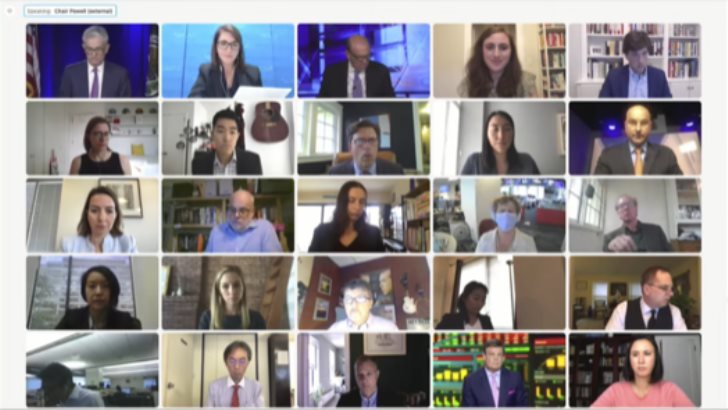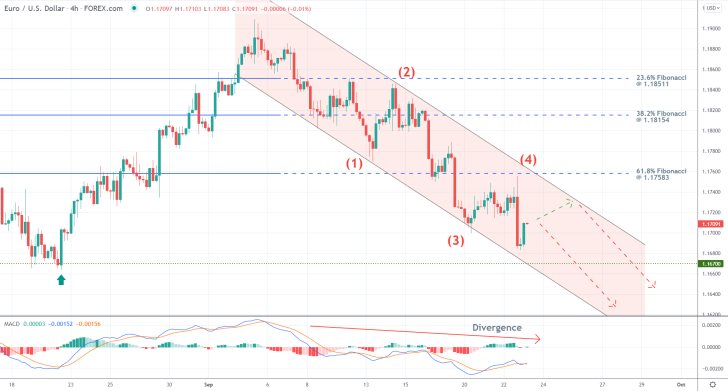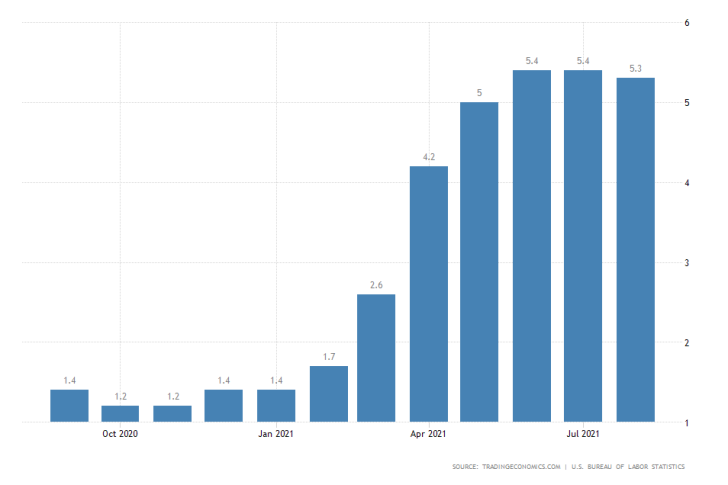
Adverse fluctuations on the EURUSD were sparked late last night following the September policy rate meeting of the Federal Reserve. Nevertheless, the underlying sentiment remains ostensibly bearish, as was demonstrated in length in our last analysis of the pair.
At the highly anticipated policy rate meeting of the Federal Open Market Committee (FOMC) of the Federal Reserve, Jerome Powell and his colleagues expectedly maintained the near-negative Federal Funds Rate unchanged at 0.25 per cent.
Mounting discord amongst the members of the Committee concerning when and by how much it would be prudent to dial back the current monetary support levels sparked heightened volatility outbursts on the EURUSD in the immediate aftermath of the meeting.

As shown on the 4H chart above, the EURUSD is currently in the process of developing a new downtrend, represented by the descending channel. It is structured as a 1-5 impulse wave pattern, as postulated by the Elliott Wave Theory.
Yesterday's monetary policy decision prompted a temporary pullback to the upper limit of the channel and the 61.8 per cent Fibonacci retracement level at 1.17583. It was catalysed by the aforementioned surge in uncertainty, resulting in heightened volatility.
The price action promptly reversed itself from this major support-turned-resistance, which seemingly resulted in the completion of the second retracement leg (3-4) of the Elliott structure.
This behaviour presupposes the likely continuation of the last impulse leg of the downtrend towards a new low. The swing low at 1.16700 represents the last remaining obstacle for bears before the price action enters into decidedly bearish territory. This is further demonstrated by the divergence that has been evolving on the MACD indicator since the beginning of the 1-5 impulse wave pattern.
The FOMC is no longer unanimous in its stance on monetary policy
Nine members of the Committee, including Char Jerome Powell, voted for the monetary policy action, while two members opposed it. Robert S. Kaplan prefers "that the Committee retain greater policy rate flexibility"; and Neel Kashkari, "who prefers that the Committee indicate that it expects to maintain the current target range until core inflation has reached 2 per cent on a substantial basis".

These disagreements on how the FED should proceed to measure the efficiency of its policy rate are prompted by the recent downturn in inflation growth. The latter was the result of easing energy prices, particularly of crude oil.
Trendsharks Premium
Gold is undergoing a correction, as investors take profits to offset losses from falling stock prices, impacting their margins. However, we anticipate a renewed wave of [...]
The Swiss stock market index is mirroring its global counterparts, such as Germany 40 and US100, experiencing a sharp decline following the announcement of new [...]
We’re analyzing the weekly chart to grasp the broader market trend. Over the past three years, the US30 index has surged by 17,000 points, often resembling a nearly straight [...]
Over the past week, the DAX has experienced a sharp decline, plunging by an astonishing 3,400 points. This downward movement is not isolated, as its international counterparts, such as the UK100 and US100, are also facing significant [...]
EURUSD recently formed a double top at 1.0930, signaling a potential trend reversal, and has since begun a correction. After a 600-pip rally since early March, a pullback at this stage is both expected and healthy. Given these conditions, we are placing a [...]
Since early March, EURJPY has surged nearly 1,000 pips, providing us with several excellent trading opportunities. However, as the rally matures, many early buyers are beginning to take profits, leading to a noticeable slowdown in the uptrend. On Friday, the pair formed a [...]
The AUDJPY currency pair continues to be dominated by bullish momentum, as multiple golden cross patterns reaffirm the strength of the ongoing uptrend. Despite this, we are witnessing a much-needed [...]
The EURAUD currency pair appears to be undergoing a trend reversal, signaling a potential shift in market direction. A notable technical development is the formation of a Death Cross on the chart, a widely recognized bearish indicator that typically suggests a [...]
After securing an impressive 200-pip profit last week, the EURJPY currency pair is now undergoing a southward correction, retracing some of its recent gains. Despite this temporary pullback, the Golden Cross remains intact, reinforcing our view that the overall trend continues to be [...]
The appearance of a Golden Cross in Silver strengthens our analysis that the metal is currently in a strong uptrend, indicating further bullish momentum in the market. This technical pattern, where the short-term moving average crosses above the [...]
This trade presents a considerable level of risk and can be classified as an opportunistic move based on recent price action. The GBPUSD currency pair has experienced a substantial bullish rally, surging by nearly 500 pips in a strong upward movement. However, after this extended period of appreciation, the pair is showing signs of a potential [...]
The anticipated Death Cross on the SMI20 appears to be failing as price finds strong support at the 23% Fibonacci retracement level. After testing this area, the index has shown bullish strength, printing several large green candles, signaling an increase in [...]
A Golden Cross has just appeared on the USDJPY chart, signaling a potential bullish move. This technical pattern occurs when the 20 period moving average crosses above the 60 period moving average, a widely recognized indication of increasing [...]
After 2 months of a down trend, we finally see some indications of price recovery for Oil. The golden cross, a historic buy signal, supports this [...]
For the past month, the German DAX40 has experienced a remarkable 10% surge, reflecting strong bullish momentum. Despite ongoing market volatility and frequent pullbacks, every dip continues to attract fresh buyers, reinforcing the [...]
Oil continues its downward trajectory, despite occasional pullbacks. The overall trend remains bearish, reinforced by multiple Death Cross patterns, a classic sell signal indicating further weakness. Adding to this bearish outlook, the critical [...]
Over the past few days, gold has experienced a sharp decline of more than $100. This downturn can be attributed in part to traders securing profits to manage their margins, which are under strain due to the significant drop in major indices. Currently, gold has fallen below the [...]
The NASDAQ 100 index is showing strong bullish momentum, as evidenced by the formation of a Golden Cross on the chart. This classic buy signal occurs when the short moving average crosses above the long term moving average, suggesting that upward momentum is [...]
The EURAUD currency pair has encountered a significant resistance level, failing to break above the critical 61% Fibonacci retracement level. This suggests that bullish momentum is weakening, reinforcing the case for a potential downward move. Given this technical setup, we favor entering a [...]
The UK100 is experiencing a remarkable rally! Over the past few weeks, the British stock market index has surged nearly 800 points. Each minor dip has attracted more buyers, fueling the bullish momentum. However, since last week, we’ve observed a slight [...]




















